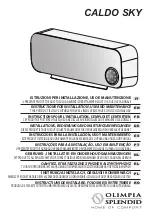
Applications manual
| 21
Panel Radiator
Design Manual
Panel Radiator Design Manual | 12.2009
Technical specifications are subject to change without prior notice
6.
Radiator Selection Procedure
Several factors must be considered in the selection of a
panel radiator. These are:
•
Heat loss of the room.
•
Location of the radiator(s) and available floor to
window height.
•
Desired piping arrangement.
•
Room usage.
•
Type of room control used.
All factors are discussed below and must be given
consideration prior to final radiator size and model
selection.
1. The panel radiator(s) must have at least the required
capacity to match the heat loss. Oversizing is not a
problem provided thermostatic sensor heads or other
temperature sensitive controls are used to cycle the heat
off once the desired room temperature is reached.
2. Radiators are frequently selected based on the
intended location. A 3’ radiator fits nicely under a 36”
window, whereas a 24” radiator may only be needed
based on the heat loss. Window size and number of
windows as well as overall room size affect the selection
process. Once a room exceeds 12’ x 12’, it is advisable to
install 2 smaller radiators on outside walls for more
comfort.
3. The selected piping arrangement affects the radiator
sizing on monoflow or one-pipe diverter valve based
systems, because the supply temperature reduces with
distance from the boiler. Minor oversizing of the last
radiators in the one-pipe system may be necessary.
4. For rooms that are used occasionally where a rapid
heat-up is required, it is advisable to install some extra
radiation. This becomes important on heating systems
operating with outdoor reset control. There is no need for
over sizing radiation in main living areas as they are
generally maintained at uniform temperatures.
5. Radiators equipped with thermostatic sensor heads on
a constant circulation system maintain a more uniform
room temperature and respond faster to temperature
disturbances such as open doors or windows, solar or
internal heat gain from appliances, lights, etc. compared
to a centrally located thermostat system.
















































